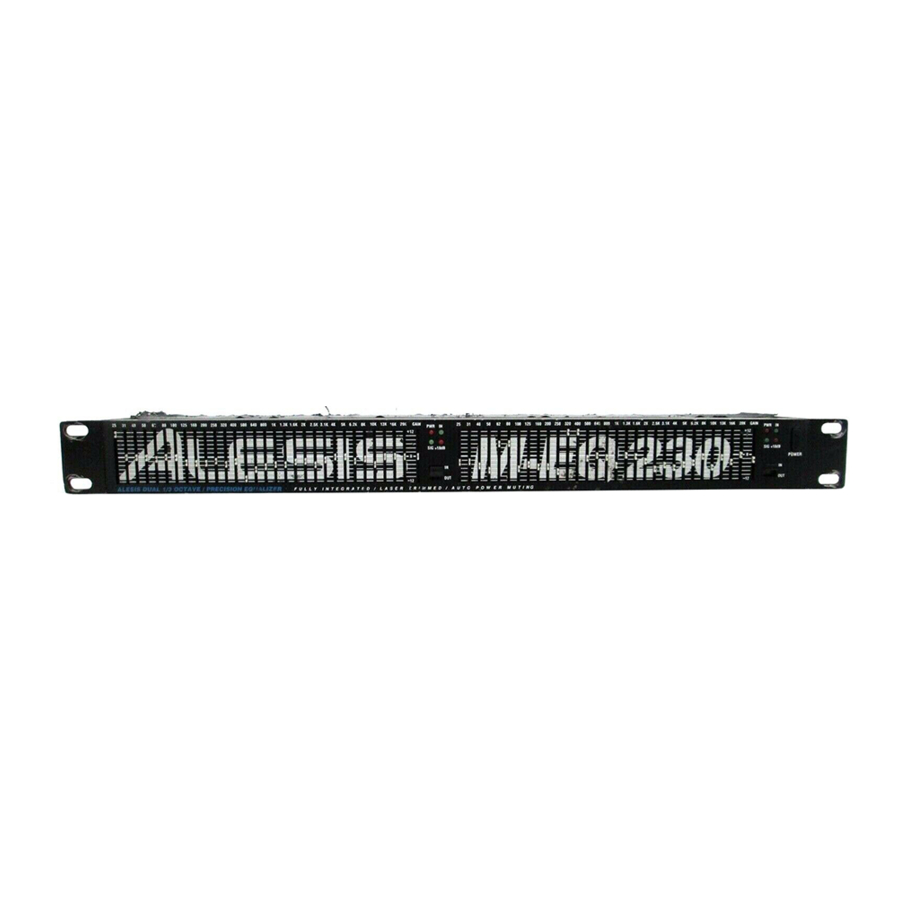
Advertisement
Advertisement
Table of Contents

Summary of Contents for Alesis M-EQ 230
- Page 1 A lesis M-EQ 230 DUAL 1/3 OCTAVE PRECISION EQUALIZATION SYSTEM USERS MANUAL...
- Page 2 A lesis M-EQ 230 DUAL 1/3 OCTAVE PRECISION EQUALIZATION SYSTEM INTRODUCTION The A lesis MEQ-230 is a two channel, 30 band/channel, 1/3rd octave graphic equalizer which features a relay based power-up delay switching circuit to eliminate turn-on transients in sound systems.
-
Page 3: Description Of Controls
SECTION 1 DESCRIPTION OF CONTROLS FRONT PANEL 1/3 OCTAVE BAND FADER Each 1/3rd octave band is controlled by a center detented fader which provides a boost or cut of 12dB. There are 30 bands per channel. MASTER CHANNEL GAIN FADER Each channel has a Master Gain Fader which controls the system's input gain by 12dB. -
Page 4: Power Jack
For stereo operation of the M-EQ 230 , connect the left and right line outputs of the device to be equalized into the left and right inputs of the M-EQ 230. See Figure 1 FIGURE 1 M-EQ 230 STEREO OPERATION Alesis 1622 MIXING CONSOLE MAIN OUT MAIN OUT... - Page 5 FIGURE 2 INDEPENDENT USE OF LEFT AND RIGHT CHANNELS Alesis 1622 MIXING CONSOLE AUX SEND OUT MONITOR OUT...
- Page 6 (if your console has them) of the channel that is to be effected. See Figure 3 FIGURE 3 INTERFACING TO A MIXING CONSOLE VIA CHANNEL INSERTS INSERT SEND Alesis 1622 MIXING CONSOLE INSERT RETURN RIGHT...
-
Page 7: Operation
SECTION 3 OPERATION POWER-UP When the power is first turned on, the automatic power-up delay circuit will mute the M-EQ 230 for 2 seconds. This is to prevent any possible turn-on transient signal from mixers, power amps, or outboard equipment from possibly damaging speakers. TO CONTROL FEEDBACK 1 ) Place all microphones in the positions where they will be used. - Page 8 B) For feedback control, the sliders of the M-EQ 230 should always be operated in the downward or cut position. FIGURE 4 CONTROLLING FEEDBACK A. Find the 2 major feedback frequencies (1 high, 1 low frequency) Slightly decrease adjacent bands. ROOM FEEDBACK FREQUENCIES ADJACENT BANDS SLIGHTLY DECREASED FOR INSTRUMENT TONAL CONTOURING...
- Page 9 the same as simply raising the volume level. In this case, do the following: 1 ) With the instrument playing, start by boosting 3 sliders at a time until the offending frequency area is found. (If LED should light, turn down the Clip 2 ) Now, decrease the sliders until you are cutting the level instead of boosting.
- Page 10 Voice Fullness at 120Hz; Boominess at 200 to 240Hz; Presence at 5KHz; Sibilance at 7.5KHz; Air at 12 to 15KHz Harmonica Fat at 240Hz, bite at 3-5kHz Conga Resonant ring at 200 to 240Hz; Presence and slap at 5KHz Whether used to alter the timbre of an instrument, control feedback, or improve speech intelligibility, it's important to know what effect each portion of the frequency spectrum has on the sound.
-
Page 11: Specifications
SECTION 4 SPECIFICATIONS ELECTRICAL CHARACTERISTICS FREQUENCY RESPONSE HARMONIC DISTORTION IN P U T NUMBER OF CHANNELS NOMINAL LEVEL MAXIMUM LEVEL IMPEDANCE O U T P U T NUMBER OF CHANNELS MAXIMUM LEVEL IMPEDANCE FRONT PANEL CONTROLS 30 Band, 1/3rd octave , 12dB, center frequencies set to ANSI and ISO standards.






Need help?
Do you have a question about the M-EQ 230 and is the answer not in the manual?
Questions and answers